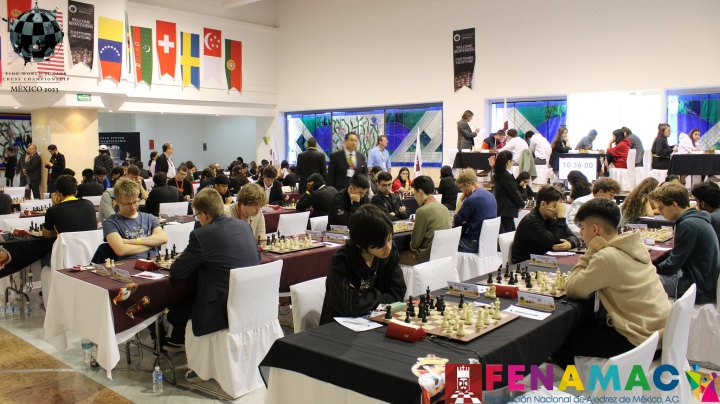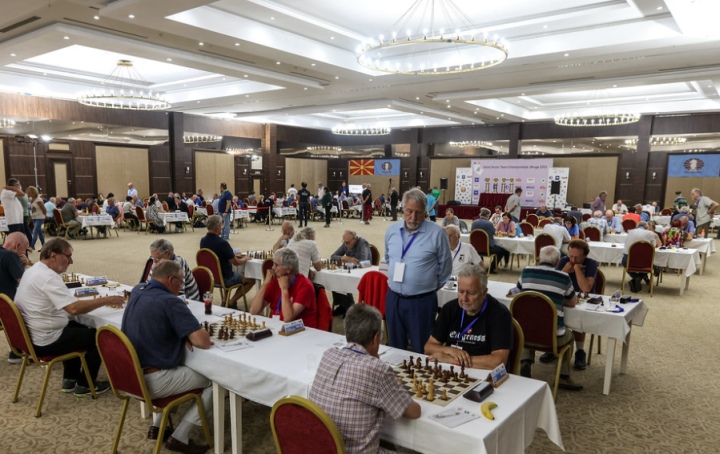World Junior Championship U20: Maurizzi and Mkrtchyan, first sole leaders after four rounds

After three days of play and four rounds, GM Marc’Andria Maurizzi (France) and WIM Mariam Mkrtchyan (Armenia) have emerged as the first sole leaders at the FIDE World Junior Championships in the open and girls’ sections, respectively. They are the only players with a perfect score of 4/4. In a field that includes a total of 14 GMs and 29 IMs, the main favourites in the open were the top-seeded GM Hans Niemann (2667), from the USA, and German GM Frederik Svane (2626). Two other serious contenders are GM Anand Pranav (2509), the current U-14 world champion, and the 2022 World Champion U-18, the Canadian IM Shawn Rodrigue-Lemieux (2485). Also notable is the presence of young chess players such as the 14-year-old American IM Andy Woodward and the Colombian Andres Garzon (2144), who is just 12 years old. The first two rounds were smooth sailing for the top seeds, winning their games with relative ease against lower-rated opponents. The first upset came in round three when GM Hans Niemann (2667) was defeated in a compelling way by his compatriot, the 13-year-old American IM Andy Woodward (2480), the youngest titled player in the field. Woodward demonstrated superb preparation for this game and played a relatively new idea against the English opening, previously used by Daniil Dubov, which involves a pawn sacrifice on e5. In this position, although White is slightly better in theory, Black has a strong initiative and it is not easy for White to find the right path. And that’s exactly what happened: on move 21, an inaccurate move by Niemann led to his loss. IM Woodward couldn’t hide his enthusiasm and ambition at the end of the game. “I am definitely very happy, and I will continue fighting all the games until the end, without giving up”, he said in this interview. He also mentioned that he already has two GM norms, and his goal is to achieve the third one in this event, besides earning some rating to close the gap to the 2500 threshold required to get the title. Another interesting result was the draw achieved by the highest-rated Mexican player in the field, IM Sion Galaviz (2462), who drew against the Indian GM Anand Pranav (2509). The games became much closer in round four, where the strongest players began to cross paths. Some well-fought games ended in a draw on the top boards, like the ones between GM Ruben Koellner (2485) and GM Arseniy Nesterov (2575), the Colombian GM Santiago Avila (2510) and American IM Kirk Ghazarian (2473). In the co-leader clash after day two, French GM Marc’ Andria Maurizzi (2555, pictured below) won his game, beating the previous day’s hero Andy Woodward (2480). In the Girls’ category, the course of the event followed a very similar script, with the main favourites imposing their better play against their opponents in the first three rounds. One of the few upsets was a half-point conceded by current American Continental Champion, WGM Candela Francisco (2345), who was held to a draw by WIM Zeinep Sultanbek (2022) from Kazakhstan. The top seed, Carissa Yip (Elo 2372), won her first three games, but in the fourth round, she had to settle for a draw against WFM Tatyana Getman (2172). The American prodigy didn’t get anything from the opening, a King’s Indian, and after the queens’ exchange, Carissa opted to go for a line that forced the draw by threefold repetition. This result allowed WIM Mariam Mkrtchyan (pictured below) to become the first sole leader of the event, as the Armenian won her game with White against WIM Sofiia Hryzlova. It was a close battle, but at some point, Sofiia decided to sacrifice a pawn to open lines against the enemy king but did not get enough compensation. Mkrtchyan was ruthless in converting her advantage, and she won her fourth straight game, the result that reminded of her dominant performance at the World Championship U-18 last year in Mamaia, where she became the winner with an astonishing score of 11 out of 11. The Girls’ category also includes some young prodigies that so far have left a very good impression with their play: 8-year-old Romi Milner (1856), from the USA; the Pan American Champion, 10-year-old Mia Guzman (1753) from Mexico; and 14-year-old WIM Miaoyi Lu (2214), from China. The most interesting clashes in Round 4 are Marc Andria Maurizzi (4) vs Arseniy Nesterov 2575 (3½) and Rudik Makarian (3½) vs. Anand Pranav (3½), while Hans Niemann (3) will take on GB Harshavardhan (3). In the Girls’ section, Carissa Yip (3½) will have White against Mariam Mkrtchyan (4), a matchup that has all the makings of a stellar duel, while on board two, the young prodigy Miaoyi Lu (3½) will face the much more experienced Candela Francisco (3½). The 5th round begins at 16:00 local time (GMT-7). Written by David Llada Photos: official webste and David Llada Official website: juniorchesschampionship.fenamacajedrez.com
Chess returns to 2023 Asian Games in Hangzhou, China

After a 13-year hiatus, chess is back to the 2023 Asian Games, which officially started on September 23, in Hangzhou, China, with a glittering opening ceremony. This return will give our game broad exposure in one of the world’s most dynamically developing parts. “Chess belongs to the family of mind sports that have a special place in the Olympic family. Currently, the International Olympic Committee doesn’t foresee chess to be included in the 2024 and 2028 Olympic games. But the development that we saw during the last few years with FIDE’s active participation gives us real hope that we will be able to include chess in Continental Games. Asian Games is one of such examples. Chess was an exhibition sport in the European Games and African Games. It is a part of the official program in some American Games, including the Central American and Caribbean Games, this year. It is a very good development. I hope that at some point a chess player will become an Olympic champion,” said FIDE President Arkady Dvorkovich in his exclusive interview with CGTN’s Liu Xin. The chess program of the 19th Asian Games features four competitions: men’s individual, women’s individual, and men’s and women’s team tournaments. The individual events with rapid time control run from September 24-27, while team competitions with classical time control will stretch from September 29 to October 7. The list of the countries-participants includes Bangladesh, China, India, Indonesia, Iran, Japan, Kazakhstan, Rep of Korea, Kuwait, Kyrgyzstan, Mongolia, Philippines, Qatar, Singapore, Sri Lanka, Chinese Taipei, Thailand, UAE, Uzbekistan and Vietnam. Many countries fielded their top players for this prestigious sports forum. We will see in action such strong and popular players as Hou Yifan, Tan Zhongyi, Zhu Jiner, Bu Xiangzhi, Wei Yi, Harika Dronavalli, Humpy Koneru, Gukesh D, Arjun Erigiasi, Vidit Gujarathi, Praggnanandhaa R, Pentala Harikrishna, Parham Maghsoudloo, Amin M. Tabatabaei, Zhansaya Abdumalik, Bibisara Assaubayeva, Dinara Saduakassova, and the winners of the 44th Chess Olympiad Nodirbek Abdusattorov, Javokhir Sindarov, Jakhongir Vakhidov, Shamsiddin Vokhidov and Nodirbek Yakkuboev. Photo: official website Official website: hangzhou2022.cn/
FIDE World Senior Team Championship: Day 5 recap

Iceland and USA are tied for the first place in the S50 section, closely followed by Italy; Germany Lasker Schachstiftung GK solely leads in the S65, with England 1, Slovakia and France trailing by two points. In the fifth round, we saw more draws than usual. Time will tell whether these were the result of match strategy, fatigue, or conservation of energy for the final rounds. The derby on the top board between USA and England 1 saw three relatively early draws. On board four, Davies (2354) had a very pleasant position with the black pieces against Novikov (2513) after successfully getting out of the opening in the Queen’s Gambit Declined with 4…a6. In the position where he offered a draw, Black was in no danger whatsoever and could have played on for a very long time. Black has a safe edge and can play on forever against White’s isolated pawn. The draw offer was surprising, especially as it was the only position where the English team could press without any risk. On board one, Adams (2662) offered a draw in a position that he didn’t really fancy, unlike the engine. The position was to Shabalov’s (2465) taste as Black was active on the kingside, but objectively, White had little to fear. Adams’s last move 19.Ra7 was a good one. Things are complicated, though, as after 19…Bc6 White needs to play 20.g3! Nh3 21.Kf1, with an advantage, but this is far from obvious. Black’s best is 19…Bd5, which leads to a messy position after 20.Rxd7 Qh6. So Adams made a practical decision to offer a draw, which was accepted. On board three Flear (2405) prepared the modern line with Bd2 in the Rubinstein Variation of the Nimzo-Indian against Ehlvest (2530) but didn’t achieve much. Ehlvest offered a draw on move 24 in an equal endgame. These draws meant that the fate of the match was in the hands of Kaidanov (2549) and Emms (2448). White won a pawn in the opening, but Black had good compensation for it. The game soon transposed to a theoretically drawn rook endgame. White played 29.Re5 in order to defend the pawn from the side with Re3. Emms defended well and successfully reduced the number of pawns on the kingside. Black waits now. White’s only try was to advance the pawn to b6 and then to try to capture the pawn on g4. On move 52, the critical position emerged on the board. Black now has a choice whether to play 52…Kg7 (in order to be ready for a possible b7) or to play 52…Rb4 first and then …Kg7. Unfortunately for Emms, after many hours of accurate defence, he made the wrong choice. The correct move was 52…Rb4! defending the pawn on g4 and only in case of 53.b7 playing 53…Kg7. Then the game and the match would have been drawn. After the mistake 52…Kg7? 53.Kxg4 Rxf2 54.Kg5, the position is won for White. White wants to transfer his king b7, but there is another threat – Rb7-c7 followed by b7, Rc8 and b8Q. Black tried to prevent the second threat and played 54…Rb2, but after 55.Rb7 Kf8 56.Kf6 The threat of mate meant that the black king needed to move. Going to g8 allows the white king to penetrate the queenside, but he could only postpone that as after 56…Ke8 57.Ke6, Kd8 fails to 58. Rb8 checkmate. Black started giving checks from behind, but the white king hid on b8 when the game was won with the elementary technique of building a bridge (the Lucena position). It was an incredibly important win for USA against one of the main competitors that allowed them to keep pace with Iceland, who also won their match. Iceland didn’t have much trouble with Montenegro. The draws on board one and four (Nikcevic (2358) – Olafsson (2491) and Thorallsson (2382) – Miljanic (2331), respectively, were from position of strength, while the Icelanders completely outplayed their opponents. A curious case happened on board three in the game Podlesnik (2289) – Arnason (2419). The game should have been drawn, but White blundered in the rook endgame and lost a couple of pawns. Then, unexpectedly, he was given a chance. Black’s last move 42…Rf5-e5 was a mistake, as the rook should have moved along the f-file to f2 or f1. Here, White should have played 43.Rd7! and the manoeuvre 43…Rh5-g5-g7 to defend the pawns doesn’t work in view of 46.Rd8 and White goes after the a7-pawn, with a drawn position. White missed this chance and played 43.a6? but after the simple 43…Re2 with the idea of …Ra2xa6 Black emerged two pawns up. On board two, Petursson (2396) defeated Pajkovic (2412) in convincing fashion. Italy continued their winning ways and beat Slovakia 3.5-0.5 with only Mrva (2361) managing a draw on board one against David (2523). Godena (2429) bested Motuz (2279) in spite of allowing an accidental drawing chance in a winning position that his opponent didn’t take, Ortega (2410) displayed exemplary technique against Dobrotka’s (2207) IQP and Borgo (2333) was superior in the complications after the opening against Kantorik (2195). The team North Macedonia Alkaloid beat Poland in a professional fashion. They had a huge rating advantage on board three, where Stanojoski (2351) faced Flis (1948) with the white pieces. So they left him to win the game while all the others drew without much fanfare: Georgiev (2542) drew Gdanski (2484), Nedev (2465) drew Sapis (2375), and Kutirov (2274) drew Masternak (2314). In the S65 section, the German team Germany Lasker Schachstiftung GK continued their excellent run, beating Israel 3-1. On board one Knaak (2438) defused an early attack and converted the extra pawn against Gruenfeld (2388), on board two Meister (2439) won a drawn double-rook endgame against Birnboim (2346) after the latter made two consecutive big mistakes. On board three, Kalintschew (2377) continued a winning streak in his unassuming way – this time Kagan (2244) managed to turn a completely harmless position on the white side of a Maroczy Bind into a lost one in several moves. On board four,

